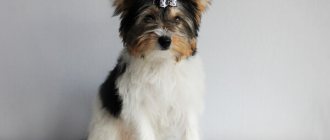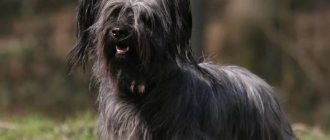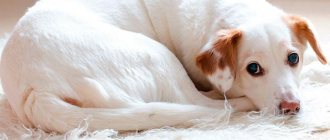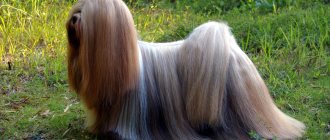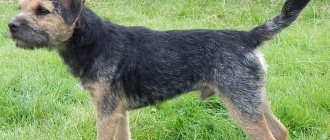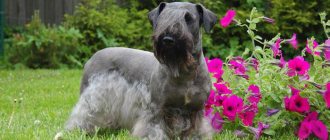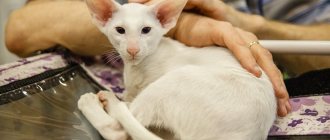The Yorkshire Terrier dog is one of the smallest indoor and decorative breeds. Its appearance resembles a cute toy that you just want to pick up and cuddle. And if the Russian Toy Terrier breed is the smallest, then the Yorkie is practically the most popular dog in the world.
Despite all its toy appearance, it is a lively, playful, intelligent dog with beautiful long, silky hair, which, however, requires serious care.
Therefore, those who are thinking about purchasing this breed should think carefully about whether they will be able to care for such a dog without harm to the rest of the family. Read this description of the breed, think it through carefully and make an informed decision.
Origin story
The Yorkie was not always a lap dog. At the dawn of the breed's history, these dogs, bred in Yorkshire, were working terriers: they destroyed rodents in houses and in mines.
Only later did they become a salon breed, and their popularization was greatly facilitated by the fact that Yorkshires were the favorites of Queen Victoria, during whose reign the breed was officially recognized.
At the beginning of the 20th century, the number of Yorkies was still small, but it was from this time that their spread throughout the world began..
The 1940s did not have the best effect on the breed, since during the Second World War people had no time for breeding dogs that had no practical value for the front.
But after its end, the number of Yorkies began to increase again, and the popularity of the breed began to revive.
By now, Yorkshire dogs are loved in many countries, including Russia . We can say that this is one of the most famous small dog breeds in the modern world.
Breed standard
According to the breed standard, the height of a standard Yorkie should not exceed 22 cm at the withers, and its weight should not exceed 3.1 kg..
The head is relatively small when compared to its size with the body. The skull is not convex, but rather flattened, the transition to the muzzle is pronounced, but not too sharp.
The dog's muzzle is short. The lips are tight-fitting and black. The chewing muscles are not very well expressed.
The teeth are even and small, there should be no gaps or, especially, gaps between them . Only a scissor bite is allowed. The nose is small and has black pigmentation.
The eyes are medium-sized, set approximately at an average level, not too protruding. The pigmentation of the eyes is brown, the darker the shade, the better. The expression of the eyes is intelligent, alert, lively.
The ears are triangle-shaped, erect, set approximately at the height of the forehead, and not widely spaced. The ear cartilage is quite thin, but elastic. The outside of the ears is covered with short hair of a rich brownish-red hue.
The body is compact, rectangular in format, without looking stretched.
The neck is of medium length and graceful lines.
The withers are weakly defined, the chest is oval in shape, not very deep or wide. The back is short, strong, and not sagging. The abdominal line is moderately tucked.
Limbs are straight and even . Elbows and hocks are parallel, but not too pronounced. Paws are collected, round in shape. The claws are black, moderately curved.
The dog usually holds its tail no higher than the spine, and only when running it is thrown over its back in the form of a plume.
The coat is very long, flowing, completely devoid of undercoat, making its texture similar to human hair.
The standard states that Yorkies' hair should be of medium length; in fact, show dogs have hair so long that it reaches the floor. The photo below shows groomed pets in clothes.
NOTE!
The color of the standard Yorkie is based on the contrast of brownish-red and steel-gray shades, slightly diluted with golden ash on the chest and paws.
In this case, the head, including the ears, is rich red, and from the occipital protuberance and below the color should be gray.
The main difficulty in breeding show Yorkies is obtaining dogs with the most saturated steel-gray coat color .
General description and characteristics
Look at the dog: its appearance suggests that it is a proud and brave animal, although it is very small.
She is proud and important, compact and graceful, smart, frisky, playful, long-haired and proportionally built.
Yorkie is a fairly active and lively dog, but at the same time it has a positive character.
Head, muzzle and ears
Head size is small. The prominent roundness of the skull is absent. The muzzle is average, cute. The nose is black.
The eyes are not bulging, dark, with shine. The eyes are positioned at an angle for straight-line vision. The look has an intelligent expression.
The ears are neat and straight set. They are not very far from each other.
The fur of the Yorkshire Terrier has a magnificent color . The reddish-brown coat is deeply colored. The muzzle and bite can be recognized immediately.
The majestic breed has a number of teeth with a pronounced scissor bite. The upper incisors are in harmony with the lower ones. The position of the fangs is straight. The neck is strong and of normal height.
Body, paws and tail
The legs are set straight in front, perfectly decorated with golden fur with a reddish-brown tint. At the ends of the hairline there is a lighter tone than at the base. The reddish-brown color must not extend above the elbow angles.
The dog's body is knocked down. The chest is correctly developed. The dog has a solid back and a tucked tummy.
The paws at the back have protruding knee bends that are at a certain angle. A visual inspection shows that the gait of the hind legs is straight. Yorkies have fairly covered paws with golden fur with a reddish-brown tint. The hairs at the ends are slightly lighter than the roots.
The tan color should extend above the bends of the knees.
The shape of the paws is round. The claws are dark. Movements, according to the accepted standard, must be active, free, and at a fast pace. While in motion, the dog should keep its back straight and its limbs pointing forward.
The tail is almost always docked. It is usually more intensely colored in a dark blue tone than the body. The tail is raised above the body line.
Recently, the UK has decided to allow animals with undocked tails to participate in exhibitions. The standard does not yet provide regulations in this regard.
The body hair is of medium size. The hair falls smoothly, there are no waves or curls. The coat is silky, shiny, glossy, quite delicate and weightless. The texture resembles human hair because it has no fluff near the body.
It gets tangled easily, so it requires daily combing with a comb and brush. The cover of the head and muzzle is quite long, fresh golden in color with a reddish-brown tint.
And in general, the tone on the sides is much richer than near the ears and on the muzzle, on which the hair is much longer.
The standard does not allow for the spread of a golden-brown color to the neck area, as well as the presence of soot deposits or its mixing with other hairs.
Briefly about character and temperament
Yorkshires are distinguished by their courage, balance and always good spirits. These dogs are affectionate and loving: they simply adore their owners and are ready to do anything to please them.
Yorkies are smart and quick-witted: they are willing to learn and train.
If it were not for their small size and fragility of build, it would be difficult to find a more suitable breed for sports, for example, agility: after all, Yorkshires are hardy and passionate, like all terriers.
It is the latter circumstance that makes them the “stars” of numerous shows and exhibitions: the Yorkie loves and knows how to show himself in the best light.
These dogs, if raised correctly, do not cause problems: they get along well with other pets and with children, but if necessary, they can also turn out to be good guards.
They also love to accompany their owners everywhere - from going to the store to traveling around the world.
The affectionateness of Yorkies also has the other side of the coin: these dogs are very dependent on their owners and do not tolerate loneliness very well..
Read more about the character of Yorkies here.
Character and training
There is no single owner for the Japanese Terrier; he loves the whole family, including its four-legged members.
In threatening situations, Nihon Terriers are fearless and even rush into battle to protect the owner, which does not always end well for the dog itself. It is worth saying that representatives of the breed perceive sharp gestures or a loud voice as a threat. While in a home, four-legged animals can bark under the door - this is a manifestation of the protective instinct.
Note! Living in a private house, the dog will also guard the yard and house. It is worth saying that Nihon Terriers have very acute hearing; they are able to detect even very quiet sounds.
The Japanese Terrier is very intelligent and quite easily learns both basic commands and complex tricks. During training, the owner must show maximum patience, since representatives of the breed do not tolerate moral pressure well.
Popular types of Yorkshire terriers and their descriptions
To date, three types of York have been bred, differing in size.:
- Standard: from 2.6 to 3.1 kg.
- Mini: from 1.5 to 2.5 kg.
- Super-mini or micro: from 1 to 1.5 kg.
All three species have the same body structure, as well as character and temperament.
The following color variations of the Yorkshire Terrier are also now known:
- standard;
- beaver;
- biro;
- goldust;
- choco;
- white;
- black.
Of all these varieties, only beavers have received official recognition. All other color variations, except for them and the standard, are considered a defect in the breed and are not allowed for exhibitions.
Baby-face Yorkies , which have a non-standard head structure and a shortened muzzle, are especially popular in the modern world .
Outwardly, these dogs look like a soft toy and can be not only standard, but also mini or micro. And the baby-face color can be any of the ones listed above.
Pets that are a cross between a toy terrier and a Yorkshire dog also look especially special . Read about this cross here.
Standard sizes, height, weight
According to the breed classification code for the RKF (Russian Canine Federation), Yorkies can be classified into several groups at once: the third (terriers), the fourth (toy terriers) and the ninth, indoor and decorative dog breeds without testing for working qualities.
The standard was adopted in the nineties of the 19th century. But over time, the Yorkie breed standard has undergone some changes. Their permissible weight of 5.5 kg has dropped to 3.2 kilograms. Now Yorkies are divided into 3 types, micro, mini and regular Yorkies.
Micro
Micro Yorkies appeared, most likely as a result of changes in hereditary characteristics even when they were used in the narrow passages of mines to catch numerous rodents. They continued to appear in litters even when the standard Yorkie was recognized, and individuals that did not meet the required size were discarded and not allowed for breeding.
Note! No matter how popular Micro Yorkies are, they are still rejected as not meeting breed standards.
Due to their high popularity, their breeding had a negative impact on the health of the dogs and their character traits. But if you approach their population wisely, taking into account genetics and heredity, then miniature copies of Yorkies should correspond in character to the main standard breed.
With a competent breeder, they retain their playfulness and affection for the owner. Dogs grow up to be affectionate, energetic, loyal and brave, despite their diminutive size. They have good relationships with the inhabitants of the house, with children, with animals.
Important! Do not forget about the incredible fragility of micro dogs due to such a small size. Even one careless movement can harm them. For this reason, families with small children should not have them.
Micro Yorkies are very dependent on their owner and become incredibly sad when left alone in a house or apartment. Not only can a person harm them, but they themselves, by jumping from a height or hitting something hard, can break something for themselves. They need hourly feeding and are dependent on weather conditions and magnetic storms.
The smallest representative of the Yorkies
It is not uncommon for micro dogs to have destructive character and mental traits and grow hysterical, aggressive or overly fearful.
Description of micro yorik parameters:
- Weight 1-1.5 kilograms.
- Coat color and lower weight parameters have no regulations.
- Their average lifespan is 5-9 years. It depends on the conditions in which they are kept, heredity, and past diseases.
For reference! The smallest dog, Sylvia, which was included in the Guinness Book of Records, weighed 113 grams with a height of 6.35 centimeters at the withers.
You need to watch the baby so that he does not fall from a height
Mini
The Mini Yorkshire Terrier was bred by breeders by selecting the smallest puppies from the litter. According to FCI standards No. 86, their height should be 15-20 centimeters, weight within 1.5-2 kilograms. Deviation from the norm leads to rejection.
Only two varieties are officially allowed - there may be a standard and mini Yorkshire terrier. Externally, they can only be distinguished by height and weight. But there are other differences.
Physiological difference:
- Mini Yorkies have more fragile bones;
- they often exhibit dropsy of the brain and dwarfism;
- they are often aggressive and unpredictable;
- Mini terriers are more dependent on people than regular Yorkies.
Interesting information . During World War II, Smoky the Mini Yorkie entertained soldiers at the hospital. They jokingly called her a doctor.
Mini Yorkie on a walk
Regular Yorkies
A standard Yorkie weighs between 2.5 and 3.5 kilograms. The fur on the body should be blue, the head and paws should be covered with golden-colored wool. All Yorkies do not tolerate loneliness well, being left alone in the apartment for a long time. They love to be in the center of events, observing the life of their household members from the height of an armchair or the master's bed.
The pet should have a place to rest that is far from drafts, quiet and cozy, where no one will disturb him. It is better to place the dog’s toilet near the front door, since all dogs tend to mark the boundaries of their territory. This can be a diaper or a tray (for males it is chosen with a column).
How much Yorkshire terriers cost depends on their parents, victories at exhibitions, competitions, as well as expenses spent on breeding, birthing and maintaining puppies before purchase. Naturally, an elite puppy with a pedigree and titled parents will cost much more than its fellow breeder, who is taken simply as a companion for the soul.
York standard
From a puppy that is barely a month old, it is impossible to determine what will grow from it in the future. Only a professional can predict this. All dogs, both expensive and not so expensive, are loved, dressed up in clothes, decorated with bows, various accessories, giving them uniqueness and individuality.
The Yorkshire Terrier requires daily brushing, care for the eyes, ears and teeth. Ears should be inspected and cleaned once a week. Your Yorkie's teeth should be regularly examined by a dentist. They must be regularly cleaned of tartar. Also, do not forget about annual vaccinations, on which the health and sometimes even the life of your pet largely depends.
Main types of colors
Beaver
It has a bright, white-black-red color and a black nose, while the proportional ratio of colors can be any: along with beavers, which have a white color with small spots, there are also individuals whose main color could be called, rather, black.
However, it is the light-colored dogs that are most popular..
Biro
It is colored white-brown-red, the location of the spots and their size may vary.
There are also almost brown biros that have a slight tan and small white markings (shown in the photo).
The nose of Biro Yorkies is brown in various shades.
Goldust
The main color of the coat is golden-fawn of various tones.
May be supplemented with small white markings.
Chocolate or choco
Its color can be any of the brown tones: from light brownish to dark chocolate.
There may be some small white markings and tan, but its color is not the deep red of the Biro, but rather a pale brown.
Black
The color of his coat should be intense black.
Small white markings are acceptable, such as a white “tie” or “socks”, as well as a narrow blaze on the forehead.
White
Such dogs are very rare (shown in the photo).
Ideally should be snow white.
The eyelids, nose and edges of the lips are only allowed to be black, and the eyes should be as dark a brown shade as possible.
Exterior
The Nippon Terrier is a very miniature dog, however, despite this, it is very harmoniously built. The height at the withers for males is only 31-33.5 cm , for females 30-32 cm , weight is 4.5-6 kg and 4-5 kg .
The skull of the Japanese Terrier is slightly flat, cone-shaped, the transition from the forehead to the muzzle is smoothed. The nose is quite large and black. The eyes are small, oval-shaped, dark in color. The ears are set high, medium in size, triangular in shape. The neck is of medium length and well muscled. The back is short, the ribs are slightly convex, the belly is tucked. The tail is thin and docked in childhood. The fore and hind legs are straight, with moderately pronounced angles of the hock and stifle joints. The fingers are gathered into a dense ball, the pads are very elastic, the claws are hard.
The coat is short (2 mm) and smooth, lying close to the skin. The color is white or brown with a black head, or white with black spots, it can also be black with red tan spots.
Breed standard
- The head is small, proportional, pointed. The forehead is flat, slightly inclined towards the muzzle, not wide. The transition to the muzzle is smoothed, with a barely pronounced furrow. The length of the forehead is equal to the length of the muzzle. The bridge of the nose is exceptionally straight, the line from the nose to the transition is parallel to an imaginary line that extends the forehead. The facial muscles are developed, but flat and stand out a little. The lips are thin, pigmented, completely hiding the teeth.
- Teeth are complete and in correct bite.
- The nose is black and small.
- The eyes are oval, proportional in size, the pigmentation of the irises is as dark as possible.
- The ears are thin, the cartilage is not hard. Standing high, ears lowered to the muzzle. The shape of the ears is triangular, the tips are rounded. The standard allows small loose folds of skin on the ears and small markings in the set.
- The body fits into a square, but the line of the back is oblique and falling. The neck is graceful, widening from the chin to the shoulders, free from folds. The chest is of standard depth to the elbows, narrowed, the ribs are drawn out, well rounded. The withers are well developed, raised, merging into a short, sloping back. The loin and arched croup blend softly, defined, strong. The groin line is tightened.
- Limbs – thin, “dry”, smooth. The shoulders are sloping, the forearms are level, the paws are set vertically. The thighs are elongated with flat muscles, the metatarsals are vertical. The angles of the joints of the hind limbs are moderately expressed, not swollen, not turned out. The hands are densely cathedral, the pads are large and elastic, the claws are curved, strong, and dark.
- The tail is thin, elastic, natural or docked.
What do boys and girls look like and how do they differ?
Like other breeds, Yorkie boys look very impressive and impressive, while girls look more graceful and gentle, and are a pleasure to look at!
Also, their head may visually look somewhat smaller in proportion than that of males.
If in other breeds of dogs boys are usually larger, then in Yorkies this is ambiguous: even among individuals of standard size, a female can be larger than a male, which sometimes creates difficulties in breeding these dogs.
Breed Features
In addition to friendliness, the breed has features that are unique to it:
- York is a friend with a capital F and a colossal companion.
- These faithful friends are among the most soulful creatures. They miraculously know how to turn into older comrades.
- The dog has a keen sense: it will curl up like a donut if you are unwell, and will sincerely rejoice at your recovery.
- Some Yorkshire Terriers have hunter instincts. Others have warmth and friendliness.
- Yorkshire Terriers reveal their personality by barking. But they bark quietly, because their organs are delicate, like themselves. If you have influence, you will be able to restrain such a frenzy.
However, if you like absolute silence, then such a “talkative” breed will not suit you. But don't forget that your pet is not barking for fun.
He broadcasts what is happening around. Listen and you will understand that the bark is strikingly different when a friend arrives, when a stranger visits, when a cat is discovered or another dog barks. In any case, you will always have a broadcast system with you. And you definitely won’t be bored.
What do the puppies look like?
The color of a newborn Yorkie puppy is black and tan, like a Rottweiler, and the fur is about the same length (as the puppies in the photo).
But as they grow older, the color of the coat begins to change, and its length gradually increases.
A small Yorkie begins to bloom from the head, the color of which changes from black to golden-red, and an adult Yorkie should have no black hairs left on the head at all.
The color on the chest and paws changes in approximately the same way and, as a result, the fur there acquires a golden-ashy hue.
The steel color begins to appear first from above: on the neck, back and rump.
At the same time, the hair itself lightens unevenly: a grayish tint appears first at its base and only then drops lower, towards the tip.
IMPORTANT!
The color is finally formed by the age of two or three, and it is not always the desired color.
Many Yorkies grow noticeably lighter in color, and in some of them the areas of contrasting colors do not have clear outlines.
With age, the texture of the Yorkie's coat also changes: from short and smooth at birth, by the time the pet is one year old, it becomes thinner, longer and silkier, as in the picture below.
How to choose a pet?
This is not too difficult if we are talking about a pet: it is only enough that the puppy is healthy, liked by the owner and more or less meets the standard.
When a future champion is bought, then everything is much more complicated.
The main problem when choosing a standard-colored Yorkie puppy is that what its final color will turn out to be can only be guessed at..
As a rule, if the litter is well-grown and the puppies have good heredity, then they look almost the same, apart from some differences in size.
And even if the puppies differ in the intensity of their tan, this does not mean anything about their future adult color.
In this case, you can focus on what color the parents of the selected puppy have. Also, if this is not the first litter born from them, then it would be nice to look at the already adult brothers and sisters of the future pet.
If exterior characteristics are of paramount importance for the future owner, then experts recommend buying not a puppy, but a young dog after coloring, which may have already won the first of its show victories.
Of course, buying a promising adult dog is not a cheap pleasure.
But such a step ensures that the Yorkie meets the requirements of the standard and that no unpleasant surprises in the form of too light or unclear color are expected.
The Yorkshire Terrier is an amazing breed. He has a silky and smooth coat, completely devoid of undercoat, which no other dog in the world has.
Born completely smooth and black and tan, the Yorkie changes color to a contrasting fawn-steel with age, and its coat grows to the ground.
However, it is precisely because of this feature, called overcoloring, that it is very difficult to predict what the color of an adult dog will be. But, regardless of size and coat color, these dogs are loved and recognized all over the world.

